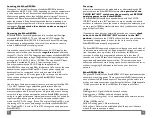
Regarding use of multi-output or shared power supplies:
The DC voltage input connection powers all the regulators on the ‘A’
side of the EtherREGEN’s isolation moat. A special isolating regulator
transfers voltage across the moat to the ‘B’ side.
Avoid powering
both the EtherREGEN and your ‘B’-side endpoint from
the same AC>DC supply
—unless you are certain the PS outputs
used do not share a common 0-volt/-VE (‘ground’/shell). If they do you
will be defeating the EtherREGEN’s sophisticated isolation.
Use of the SFP cage with fiber-optic modules:
Use of optical into—or out of—EtherREGEN is not required to obtain
best performance.
The whole point of all the isolation and
re-clocking techniques we are using (in dual domains) is
to make most all of the upstream stuff not matter.
Other
than the complete galvanic isolation that optical offers going into the
EtherREGEN (which we duplicate going across the moat), there is likely
no advantage to running optical into it.
If you happen to have a router with an optical port and have already run
many feet of optical cable to your music system rack, then sure, use the
optical port of the EtherREGEN. But don't go out of your way to run
fiber-optic if you do not already have it.
For the few people who have an endpoint with optical input (the
excellent Sonore opticalRendu comes to mind), one can “turn around”
the EtherREGEN and feed that DAC-connected endpoint from the
optical cage, while connecting the lone ‘B’-side port to the network.
Thus ‘B’ >’A’. The EtherREGEN’s SFP cage is on the ‘A’ side of its
active differential isolation moat. Since it is preferred that your audio
endpoint (DAC-attached streamer/renderer) be alone on one side of
the moat, users who connect an optical endpoint should avoid
connecting any other devices to the other ‘A’-side ports (the four RJ45
copper ports).
Only Gigabit LC-optical or copper interface modules are
compatible with the SFP cage of the EtherREGEN. They
can be SX multi-mode, LX multi-mode, or LX single-
mode, as long as they are Gigabit and match what is used
at the other end of the optical cable.
The modules at each end can be from different manufacturers as long as
their type and mode specifications match. While some manufacturer’s
switches work only with special “branded” SFP modules, that is just an
ID code stored in the module. The EtherREGEN ignores this code so
any Gigabit SFP module can be used regardless of manufacturer code.
9
Extreme usage with an external reference clock:
The Crystek CCHD-575 oscillator used in the EtherREGEN is one of
the lowest phase-noise production crystal oscillators (XO) available.
[Sorry, but the $50~$100 OCXOs we see tossed into stock switches
do not outperform the Crystek at low-offsets where it counts;
Manufacturers have to spend $500 and up to obtain OCXO clocks with
significantly lower phase-noise than the Crystek we use.]
Yet some audiophiles have discovered benefits using expensive ultra-
low-jitter/low-phase-noise 10MHz reference clocks with their DACs or
USB streamers and conditioners. A clock synthesizer (to generate the
various frequencies) is always required for a device to accept an
external reference clock. Since we already utilize a very advanced one
to produce the 4 clock lines in the EtherREGEN, it was easy for us to
include provision for connection of an external 10MHz clock.
The BNC jack and termination resistor of the EtherREGEN are for a
75ohm clock line. (Unless you special-ordered your unit with 50 Ohm
BNC and termination resistor—in which case your unit has a small
‘50 Ohm’ label affixed.)
If you are going to attach an external 10MHz reference clock to the
EtherREGEN, then you must move the small switch labeled “CLOCK
INT/EXT” to the ‘EXT’ position.
In order for the EtherREGEN
to correctly program its clock synthesizer chip to use
either the Internal (Crystek XO) or External clock as
reference, the CLOCK INT/EXT switch must be set
BEFORE DC power is applied.
Programming will not occur if the
CLOCK switch is moved after DC power is applied.
The sequence to utilize an external reference clock with the
EtherREGEN is:
1)
Remove DC power from the EtherREGEN.
2)
Set the CLOCK INT/EXT switch to the EXT position.
3)
Connect a BNC clock cable from a 10MHz reference clock.
4)
Power on the reference clock.
5)
Apply DC power to the EtherREGEN.
We hope the EtherREGEN enhances your music system.
10
























